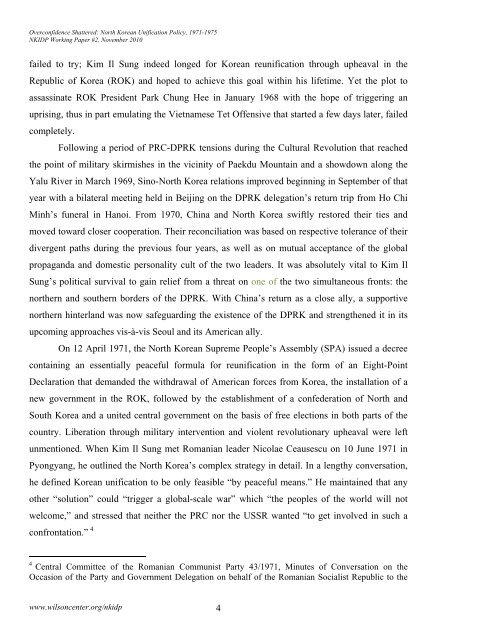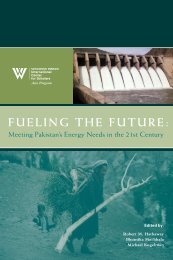Overconfidence Shattered: North Korean Unification Policy, 1971 ...
Overconfidence Shattered: North Korean Unification Policy, 1971 ...
Overconfidence Shattered: North Korean Unification Policy, 1971 ...
- No tags were found...
You also want an ePaper? Increase the reach of your titles
YUMPU automatically turns print PDFs into web optimized ePapers that Google loves.
<strong>Overconfidence</strong> <strong>Shattered</strong>: <strong>North</strong> <strong>Korean</strong> <strong>Unification</strong> <strong>Policy</strong>, <strong>1971</strong>-1975NKIDP Working Paper #2, November 2010failed to try; Kim Il Sung indeed longed for <strong>Korean</strong> reunification through upheaval in theRepublic of Korea (ROK) and hoped to achieve this goal within his lifetime. Yet the plot toassassinate ROK President Park Chung Hee in January 1968 with the hope of triggering anuprising, thus in part emulating the Vietnamese Tet Offensive that started a few days later, failedcompletely.Following a period of PRC-DPRK tensions during the Cultural Revolution that reachedthe point of military skirmishes in the vicinity of Paekdu Mountain and a showdown along theYalu River in March 1969, Sino-<strong>North</strong> Korea relations improved beginning in September of thatyear with a bilateral meeting held in Beijing on the DPRK delegation’s return trip from Ho ChiMinh’s funeral in Hanoi. From 1970, China and <strong>North</strong> Korea swiftly restored their ties andmoved toward closer cooperation. Their reconciliation was based on respective tolerance of theirdivergent paths during the previous four years, as well as on mutual acceptance of the globalpropaganda and domestic personality cult of the two leaders. It was absolutely vital to Kim IlSung’s political survival to gain relief from a threat on one of the two simultaneous fronts: thenorthern and southern borders of the DPRK. With China’s return as a close ally, a supportivenorthern hinterland was now safeguarding the existence of the DPRK and strengthened it in itsupcoming approaches vis-à-vis Seoul and its American ally.On 12 April <strong>1971</strong>, the <strong>North</strong> <strong>Korean</strong> Supreme People’s Assembly (SPA) issued a decreecontaining an essentially peaceful formula for reunification in the form of an Eight-PointDeclaration that demanded the withdrawal of American forces from Korea, the installation of anew government in the ROK, followed by the establishment of a confederation of <strong>North</strong> andSouth Korea and a united central government on the basis of free elections in both parts of thecountry. Liberation through military intervention and violent revolutionary upheaval were leftunmentioned. When Kim Il Sung met Romanian leader Nicolae Ceausescu on 10 June <strong>1971</strong> inPyongyang, he outlined the <strong>North</strong> Korea’s complex strategy in detail. In a lengthy conversation,he defined <strong>Korean</strong> unification to be only feasible “by peaceful means.” He maintained that anyother “solution” could “trigger a global-scale war” which “the peoples of the world will notwelcome,” and stressed that neither the PRC nor the USSR wanted “to get involved in such aconfrontation.” 44 Central Committee of the Romanian Communist Party 43/<strong>1971</strong>, Minutes of Conversation on theOccasion of the Party and Government Delegation on behalf of the Romanian Socialist Republic to thewww.wilsoncenter.org/nkidp 4
















